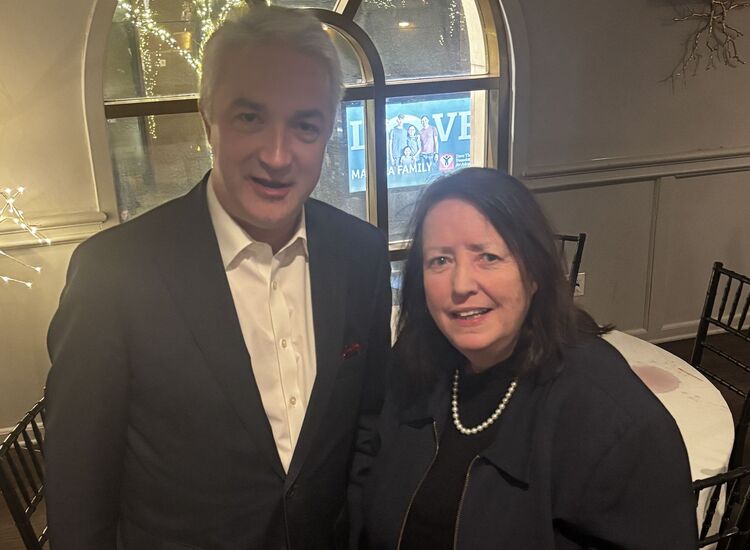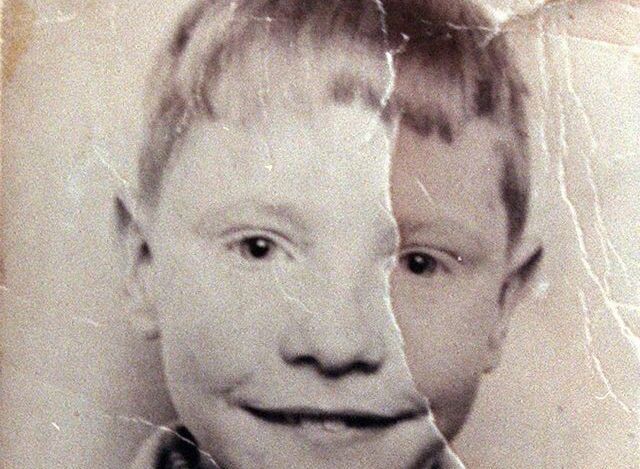[caption id="attachment_66930" align="aligncenter" width="600" caption="Big Jim Larkin in iconic pose. "]
James Larkin was dead and gone for more than a decade by the time I was born.
But "Big Jim" had created waves in his lifetime and they would lap at my feet in three distinct ways during the course of my own, a span on earth that, thus far at least, has been rather less tempestuous than the years presented to Larkin, who hailed from one of the world's great Irish cities, Liverpool.
For sure, Larkin came up for mention in that school history book. It was hard to ignore the man, such was his larger than life role in the Irish union movement, and the birth of what would be, for a time, the Irish Free State.
But though he was departed from life's picket lines, James Larkin would return to life before my very eyes.
It was at the tale end of the 1970s, and while I was still allegedly studying at university I had also joined my first union, Equity, the one representing thespians and the likes of yours truly, what the union handbook referred to as a "crowd panel extra."
As an extra, I worked in a couple of movies, a famous Irish TV show of the day, and a few TV commercials. One of the movies was "Strumpet City," based on the James Plunkett novel and which told the tale of the Great Lockout in Dublin in 1913, a bitter fight in which the battling workers were led in large part by James Larkin.
So in one scene there I was in a crowd gazing up at Larkin as he struck that iconic pose, long arms stretched to the heavens, imploring the gods of labor to strike down the evil bosses.
It wasn't Larkin himself of course, but an actor who could sure have you believe that you were in the presence of the true man. That actor was Peter O'Toole.
The thing about being an extra is that you can sometimes be handed different roles in the same film. And while I was a worker in thrall to Larkin in one scene, I was a starch-collared member of Dublin's middle class in another. My task, and that of my fellow starch-collars, was to prevent Dublin kids being evacuated to Godless England during the Lockout.
While there was no God across the water, at least as far as we were concerned, the opposing view was that there would be some food on the table. The scene depicted the recreation of a big fight on the Dublin docks between the two sides. As I recall, I decked a couple of workers and might have knocked one on the head with a placard.
I don't remember it as my finest hour, even though it was in the interest of art.
Roll the cameras a few years and I have left the Dublin docks well in my wake and am standing on the banks of the Hudson River, up that river a ways from New York City, in Ossining, Westchester County.
This is my American home, and that of my Irish American family. It was also Larkin's home for a time. But while I have a hedge outside the front door, Big Jim had some very high walls.
His address was on Hunter Street, though that was just for mailing purposes. His actual abode was at the end of that street and behind the ramparts of Sing Sing Prison.
Getting to work involves taking the train on the Hudson line. The line runs through Sing Sing, it being a two-sided facility with one half on a hill, and the other down at river level. A secured walkway over the tracks allows for movement between both.
A prison makes you stop and ponder. Or at least it should. One thing that many people consider when the name of one of the county's most famous/infamous jails enters the conversation is "Old Sparky," the electric chair. Sing Sing was once a place of death in addition to incarceration. Over 600 people had their lives snuffed out in the place by electric current.
By contrast, Sing Sing may well have saved James Larkin's life.
If witnessing the recreation of Larkin by a famous actor was the first wave, and Sing Sing the second, the third would be a most unusual story which surfaced in the first weeks of 1999.
It concerned Larkin, but not only him. It pointed to what seemed to be a plan to assassinate a man who was making a habit of causing headaches for a lot of powerful people.
Larkin came to America in 1914 and threw himself headlong into the struggle for workers' rights. By 1920 he was doing a five to ten year stretch in Sing Sing for "criminal anarchy."
At the same time, though he likely never knew it, he had also been sentenced to death, though not by the courts.
Simply put, there was a plot against Larkin. The plot first came to light in 1998 when Claire Culleton, an associate professor of Modern British and Irish Literature at Kent State University in Ohio, obtained an old dusty file during follow-up research that originated with her interest in possible FBI files on James Joyce.
Culleton had applied under the Freedom of Information Act for a file on Joyce; but one Irishman named James was apparently as good as another as far as the feds were concerned. Instead of Joyce, she was given a Larkin file, 490 pages thick and which included a "Special Report" on the alleged plot compiled by a special agent assigned to the New York office of the Bureau of Investigation, the predecessor of the FBI.
The back story in that file was one of division and dissent in the ranks of Sinn Féin with Larkin on one side and, the file seemed to suggest, Eamon de Valera and his American allies on the other.
The secret file, dated Dec. 2, 1919, gave details of a plan by four men to carry out the assassination of Larkin. The uncovered plot went so far as to have Larkin replaced by a look-alike who would return to Ireland and impersonate him.
The reason for the planned assassination, according to the report, was that Larkin was seen by the plotters as being opposed to Sinn Féin - this on the grounds that the party had become too capitalistic.
The names of the four alleged plotters were blacked out on the file first obtained by Culleton.
The typed file, headed "In Re James [Jim] Larkin Radical," opens with the federal agent stating that he had received the information from a source that he considered to be "absolutely reliable and conservative."
While the filed report was dated Dec. 2, the meeting of the four plotters had taken place in New York City several days earlier, on Nov. 24. The report appears to have been written the following day. The special agent began his report thus: "At a meeting held last night in this city [location known to the writer], the decision that Jim Larkin must be assassinated for the good of the Irish Republic was arrived at by the following:"
Four names were then listed, but were all inked out on the file obtained by Culleton. A notation beside the names, "b7C," was shorthand for a section of the United States Code that reads: "Could reasonably be expected to constitute an unwarranted invasion of personal privacy."
However, after the Echo filed its own freedom of information request, the FBI decided that enough time has passed and that the names of the four alleged plotters could be made public.
They were named in the 1919 report as: Brian McGann; Shaun Kavanaugh and "Pat" Quinlan." The fourth alleged plotter was only partially named. His surname was Redmond, but there was a question mark inserted for his first name. Quinlan was known to be a close ally of activist John Devoy of Clan na Gael.
The special agent subsequently referred to the plotters as the "committee of disposal." He stated that the committee had been informed that Larkin possibly intended to either jump bail, defeat the case against him at the time, or jump bail upon conviction.
Larkin would then "flee" to Ireland in time for the January 1920 elections. In Ireland, Larkin's presence would "mean that he will do all possible to arouse the Irish Socialist vote against the Sinn Fein, whose policies, according to Larkin, are capitalistic and not in accord with good Socialist doctrines."
The report indicated that the four plotters intended to take "every means" to prevent Larkin's return to Ireland. One of the assassination methods discussed at the meeting was "the use of cyanide of potassium." The cyanide option was presented to the gathering by Quinlan, according to the agent's report.
The federal agent concluded that "all of the aforementioned plotters are men of the type who will not hesitate at violence of any sort to attain their ends."
The report on the plan to murder Jim Larkin also mentioned a fifth individual either close to, or directly involved, with the other four men. The unidentified federal agent stated at one point that he had been advised by his source that a man "who is 'consul general to the Irish republic' in the City of New York, is charged with the duty of protecting an individual [whose name is at present unknown to informant] who bears a striking resemblance to 'Jim' Larkin."
Previous speculation as to identity of this individual focused on Patrick McCartan, a County Tyrone native who was known to be acting at the time as putative consul general for the nascent republic. However, the uncensored bureau report obtained under the Echo's FOIA request did not name McCartan.
It Stated: "I am further advised from the same source that a man named Fawcett, who is 'consul general to the Irish Republic' in the City of New York, is charged . . . "
This Larkin look-alike under Fawcett's care, described only as a "stoker," was to be "kept under cover until such time as Larkin is disposed and then he will journey to Ireland and, impersonating Larkin, will take steps to influence the Irish Socialist forces to line up with the Sinn Fein."
The spelling "Fawcett" was probably an error on the agent's part. The reference was most likely to Diarmuid L. Fawsitt, a senior figure in Sinn Féin who was appointed at this time by Eamon de Valera as the Republic's trade consul in New York.
If this was the case, there appears to have been a potential link between the alleged plotters and de Valera, although there is no evidence to this day to suggest that Fawcett, or Fawsitt, if he was involved at all, was acting under de Valera's direct orders.
Indeed, as detailed in Tim Pat Coogan's 1993 biography of de Valera, Fawsitt and de Valera entered into a dispute around this time over the trusteeship for $3 million collected by de Valera in his U.S. bond drive on behalf of Dáil Eireann.
The plot, of course, was never carried to its potentially deadly end. Larkin's safety may well indeed have been inadvertently aided by his trial. Court proceedings opened on April 5, 1920. Three weeks later, Larkin was found guilty of criminal anarchy and imprisoned. Larkin was pardoned by Gov. Al Smith in January 1923.
For several months before returning to Ireland, however, Larkin continued to tour the U.S. agitating on behalf of labor's cause. The Bureau of Investigation was with him all the way, as another once "Confidential" bureau report on his activities reveals.
The report, which also turned up in the Larkin file, originated in early February 1923. Labeled "Cleveland File No. 2102," it outlined the work by bureau agents, local police and "undercover agencies," in Cleveland, where Larkin was expected to speak at a meeting on Feb. 6.
The report revealed that various halls in Cleveland in which Larkin would be expected to speak were "covered" by federal agents, but no information was secured as to Larkin speaking in the city.
The agents then discovered, by away of a "confidential informant," that Larkin was not going to speak in Cleveland at all but had just done so at a meeting, two days earlier, in Chicago. The informant provided details of the Chicago meeting to the bureau.
In that meeting, according to the bureau account, Larkin revealed that he had been told of another plot against his life.
"Jim Larkin was effusively introduced as the next speaker, and spoke for two hours," the bureau report stated.
"He said that the key to the Irish situation is the six counties of Ulster, which British Imperialism, thru the capitalist class, is holding by political and economic movements.
"He then told of a unique ship which he is planning to take to Ireland this spring. He said that legend had it that deliverance for Ireland must come from the sea, and that gave him the idea of sending the ship to them with food, clothing etc. He stated that the ship would sail from N.Y. Harbor on or about Easter Sunday, and would arrive in Ireland about the 29th of April. He said 'I know we will have many obstacles in our way, and they may even give us a fight, but I will sink the ship before I will give it up to England.'"
Larkin then told the assembled gathering that he had warned of a plot against his life. The plot "was on foot to have him go to Clinton, Iowa."
Larkin said that he had been warned that if he accepted the invitation, "I would be killed for the sole purpose of preventing my going to Ireland. The invitation came to me just as he stated, and I am satisfied there is a conspiracy to put me out of the way; and the worst part of it is that this country has a part in the conspiracy, because it is linked up with the other countries."
The bureau report's account of the Chicago meeting ends with Larkin's concluding words: "Some may think I am going over to Ireland to pull the chestnuts out of the fire, but you may depend upon it, if I pull them out, I will crack them. If I die in the struggle, there will be other leaders who will follow me as I am following those who went before me."
Larkin survived his American years. He would also survive his return to Ireland where, in time, he would be elected to the Dáil. He died from natural causes in 1947.
A statue depicting Larkin in his famous arms reaching to the sky gesture now stands in Dublin's O'Connell Street.
As memory serves me, the statue has Larkin doing a pretty good imitation of.........Peter O'Toole.








